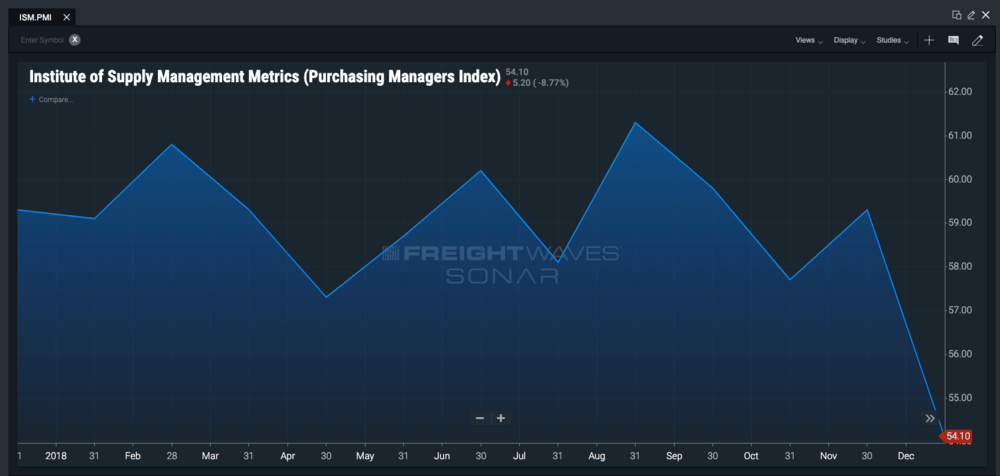Good day,
SONAR data sourced from the U.S. Purchasing Managers Index (PMI) technically ended 2018 in expansion mode as defined by the Institute of Supply Management (ISM), but there are signs within the index components that point to a downturn in manufacturing activity. Anything less than 50% is considered a contraction.

While production was the lowest of any month in 2018, and in clear retreat from the previous November numbers at approximately 10% higher, the numbers are still far higher than anything we saw in 2016.

Commentary from ISM’s monthly survey makes it clear that manufacturers are blaming tariffs. “Growth appears to have stopped. Resources still focused on re-sourcing for U.S. tariff mitigation out of China,” they write. “Customer demand continues to decrease [due to] concerns about the economy and tariffs…Starting to see more and more inflationary increases for raw materials. Also, suppliers [are] forcing price increases due to tariffs.”
Did you know?
Data from the Job Openings and Labor Turnover Survey (JOLTS) showed that the number of job openings fell to 6.9 million in November, down from 7.1 million in the previous month. Despite the decline, there are still nearly a million more job openings than there were at this point last year.
Quotable:
“When you think about the engines of the global economy, they’re all going to lose momentum.”
—World Bank economist Ayhan Kose
In other news:
Samsung echoes Apple’s gloomy outlook as tech woes get worse
South Korean tech giant expects fourth quarter operating profit will fall 29%. (WSJ)
US-China trade talks wrap up after extending to third day
After extending to an unexpected third day, trade talks between U.S. and Chinese officials have concluded. (NPR)
Weakest treasuries demand since 2008 sends bond-market warning
Bid-to-cover ratio hits decade-low as Treasury supply surges. (Bloomberg)
PANYNJ opens ExpressRail intermodal facility
The GCT Bayonne ExpressRail Port Jersey opened for business yesterday at the Port of New York and New Jersey. (Progressive Railroading)
Disruption from Brexit and trade wars could mean uplift for air freight
The global air freight market is likely to benefit from a no-deal Brexit and from potential crises around the world this year. (The Loadstar)
Final thoughts:
On Monday, the energy data and consulting firm Rystad Energy released a report showing that daily fracking jobs for trucks reached a peak of 48-50 in May and June of 2018 before gradually declining to about 44 jobs per day in November. Because fracking is so trucking-intensive – the sand, water, and chemicals must be transported to a large number of shifting production sites – FreightWaves wanted to see if the same curve was present in flatbed trucking prices and tender rejections.
Hammer down everyone!










